Exploring Local Wind Patterns for Water Sports
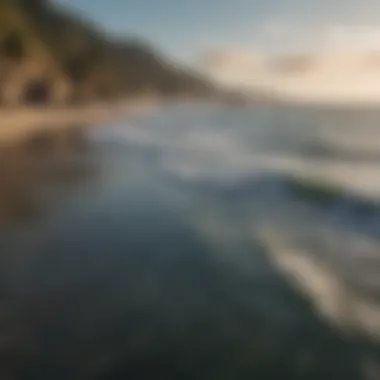
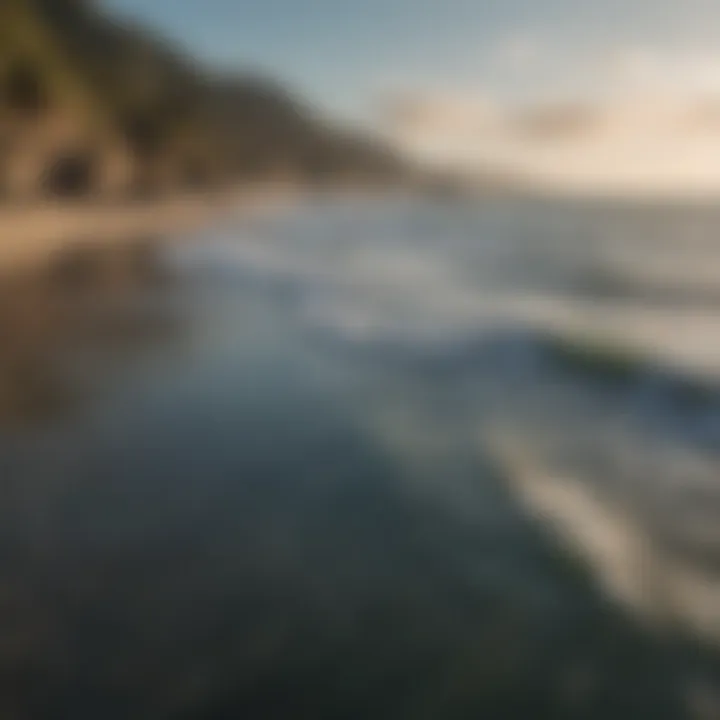
Intro
Understanding wind patterns at your specific location can be a game changer, especially when it comes to water sports like surfing, kitesurfing, or paddleboarding. Rather than simply bundling up your gear and heading out, knowing how local winds behave can seriously enhance your experience on the water. With various factors at play, from geographical influences to seasonal changes, it’s essential to get a firm grip on these elements.
As we dive deeper into this topic, we’re not just going to throw around jargons. We'll take a closer look at how the lay of the land and the atmosphere around you come together to create those gusts and breezes you feel. Whether you’re planning a laid-back surf session or something more adrenaline-pumping, understanding current wind dynamics is a step in the right direction.
So, strap in as we explore everything from equipment essentials to techniques that can enhance your performance. Expect an enriched narrative filled with insights aimed at surfers, paddleboarders, and kitesurfing enthusiasts, as well as instructors and gear reviewers who keep an eye on the latest trends.
Prelims to Local Wind Conditions
In the realm of water sports, understanding local wind conditions isn't just a helpful tip—it's downright essential. The wind dances across the water, forming waves and currents that can either elevate your performance to new heights or throw a wrench in your plans. If you’re a surfer, paddleboarder, or kitesurfer, grasping the nuances of wind patterns can shape your entire experience on the water.
Knowing how the wind behaves in your area, such as its typical direction and speed, can substantially improve your planning and decision-making. Without this knowledge, you may struggle against unanticipated conditions, leading to frustrating sessions instead of thrilling rides.
The Importance of Wind in Water Sports
For water sports enthusiasts, wind is the silent force that dictates the tides of their adventures. Whether it’s creating the perfect wave for surfing or providing the lift needed for kitesurfing, wind conditions directly impact performance.
- Surfing: Waves are born and molded by the wind. Offshore winds tend to clean up the waves, making them more powerful and easier to surf. Onshore winds, however, can create choppy conditions. Understanding local wind dynamics helps surfers time their outings for optimal waves.
- Kitesurfing: The art of kitesurfing relies heavily on wind direction and strength. Knowing your local wind patterns enables kitesurfers to choose the right equipment and stay safer on the water.
- Paddleboarding: For paddleboarders, winds can affect paddling efficiency and maneuverability. Understanding the wind can make the difference between a leisurely cruise and a fight against the elements.
Wind is not merely a backdrop; it’s an integral part of the water sports experience.
Basic Meteorological Concepts
To truly understand local wind conditions, a grasp of some basic meteorological concepts is invaluable. Wind is created due to differences in air pressure, which in turn result from temperature variations caused by the sun’s heating. A few foundational concepts include:
- Air Pressure: High and low-pressure systems interact to create wind. High-pressure areas generally produce calmer winds, while low-pressure systems often bring stronger gusts.
- Temperature Gradients: Different surfaces heat up differently. For example, land heats faster than water, leading to varying pressure systems that affect wind patterns.
- Coriolis Effect: This refers to the way that the Earth's rotation impacts wind direction, causing it to curve rather than flow straight.
Understanding these principles can offer insight into why the wind in your location behaves the way it does, empowering you to leverage this knowledge for improved water sport experiences.
"A keen awareness of local wind patterns transforms the unpredictable into the manageable, allowing enthusiasts to ride the waves with confidence and skill."
Through this groundwork, we move toward examining specific elements like wind speed and direction, crucial tools for navigating the aquatic landscape.
Understanding Wind Speed and Direction
Understanding wind speed and direction is pivotal for anyone who enjoys or instructs water sports. These two elements are the fundamental building blocks that shape the experience on the water. Whether you are a surfer catching waves or a kitesurfer soaring through the air, grasping wind dynamics can elevate your understanding and capability significantly.
Measuring Wind Speed
Wind speed is more than just a number; it’s a critical factor that determines safety, performance, and the type of gear you'll need while engaging in water sports. Knowing how fast the wind is blowing influences everything from choosing the right surfboard to deciding when to throw the kite in the air.
- Anemometers: This device is the gold standard for measuring wind speed accurately. A hand-held anemometer can give you instant readings, but stationary weather stations often provide more comprehensive data. Knowing when wind conditions are steadily above 15 miles per hour can signal ideal surfing prospects but could also mean wavy challenges for novice paddlers.
- Beaufort Scale: A traditional tool still relevant today, this scale categorizes wind speeds into simple descriptions. For instance, a force of 3 indicates a gentle breeze that might rustle leaves, while a force of 6 signifies a strong breeze that can generate larger waves and should command respect from anyone heading out on the water.
- Local Observations: Sometimes, firsthand observations can complement measured data effectively. If you notice flags snapping vigorously at the local beach, or if the trees are swaying more than you’d prefer, take those cues seriously. Wind can often pick up unexpectedly, and being attuned to local signs is as valuable as checking your smartphone app.
Wind Direction Explained
Wind direction plays a critical role in how you experience and navigate on the water. It not only affects wave formation but also influences currents and your own path when out paddling or surfing. Understanding it can set you apart from the crowd as a savvy, in-tune water enthusiast.
- Understanding Degrees: Wind direction is often referenced in degrees, with 0° representing wind blowing from the north. Knowing that a south wind means waves might be coming in on your way to the surf can revolutionize your strategy for selecting a spot to ride.
- Crosswind vs. Headwind: Crosswinds add complexity to maneuvering while headwinds can be a workout. Paddling against a headwind requires significant effort, while riding a crosswind means you might want to adjust your angles for optimal performance. It's wise to assess collaborations between wind direction and water current when planning your outing.
"Wind is the invisible hand that shapes our watersport experiences, guiding us towards adventure but also demanding respect."
Grasping these fundamental aspects of wind speed and direction not only enhances your skills but also ensures a safer and more enjoyable experience on the water. Make it a habit to check your local wind metrics regularly, as the conditions can change faster than a flick of a switch.
Factors Influencing Wind Patterns
Understanding wind patterns isn’t just about knowing which way to paddle or how to position a sail; it’s critically tied to various elements that shape those very winds. Several factors come into play when it comes to wind behavior in your local area. Analyzing these influences helps surfers, kitesurfers, and paddleboarders optimize their experience on the water.
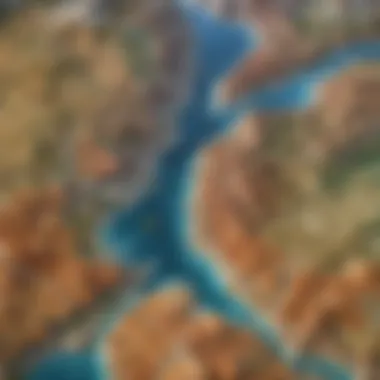

Topographical Influences
The landscape around you has a significant impact on local wind patterns. Mountains, valleys, and bodies of water can create a unique wind environment that can shift dynamically based on geographic features.
- Elevation Changes: The terrain’s elevation often dictates how air flows. High mountains can block or redirect winds, leading to sheltered spots or even turbulent conditions in the valleys below. You might find that a peak creates a warm downdraft that contributes to faster winds in the vicinity.
- Urban Areas: Buildings can also affect wind strength and direction. When wind hits a series of structures, it often can create the “venturi effect,” causing gusts to intensify in certain streets or open spaces. For example, in a place like San Francisco, air pressure differences around the Golden Gate Bridge create unique surfing conditions.
- Coastal Geography: Similarly, coastal features such as bays and beaches can alter wind patterns. Sea breezes develop as warmer land heats up and cools off faster than the water, which can be advantageous for those looking to take on nice afternoon surf.
By keeping an eye on your local terrain, you can better predict how winds will behave on any given day.
Weather Systems and Their Impact
Weather systems play a huge role in shaping wind patterns. These systems, whether they be high or low pressure, bring different air movements that affect conditions on the water.
- High-Pressure Systems: These are typically associated with stable, clear weather. Winds are lighter and tend to come from a more consistent direction. This stability is often pleasant for paddleboarding or leisurely sailing but may not provide the adrenaline rush some kitesurfers seek.
- Low-Pressure Systems: On the flip side, low pressure can create stormy weather with unpredictable winds. When a storm system moves in, winds can shift rapidly, creating choppy, challenging conditions. Surfers often anxiously await the arrival of a low-pressure system, as it can sometimes lead to epic swells.
- Cold Fronts: These can bring sudden, strong winds. When cold air pushes into an area, it can lift warmer air swiftly, leading to gusty conditions. If you're planning to hit the waves, this can bring some of the best surfing setups — just don’t forget to check those forecasts!
In essence, understanding how various weather systems affect the winds can give you an edge in planning your time on the water.
Seasonal Variations
Just like the changing scenery, wind patterns aren’t set in stone throughout the year. Seasonal discrepancies can greatly influence your water activities.
- Summer vs. Winter: During the summer months, winds are often more stable, establishing consistent sea breezes that can be perfect for kitesurfers. Conversely, winter months may usher in more dynamic conditions driven by cold fronts and storms, which can lead to bigger waves for those willing to brave the chill.
- Changing Jet Streams: The position of jet streams shifts with the seasons. This can bring different weather patterns and wind conditions. For example, as summer wanes into fall, you may notice that winds start becoming more variable.
- Regional Trends: Different regions experience different wind patterns based on geographic and climatic factors. For example, the trade winds in tropical areas can create consistent oceanic conditions year-round, while temperate zones may see more variability throughout the seasons.
"Understanding how seasons influence local wind patterns is crucial for strategizing your time on water, be it kitesurfing, paddleboarding, or surfing."
All in all, by grasping the local factors that affect wind patterns, you can make informed choices about when and where to engage in your favorite water sports. Staying ahead of changing conditions enhances not only enjoyment but also safety on the water.
Practical Applications for Watersports
Understanding wind patterns has profound implications for various water activities. For surfers, kitesurfers, and paddleboarders, recognizing how local winds can either enhance or impede performance is key. By being aware of how these elements interconnect, enthusiasts can make more informed decisions about when and where to engage in their favorite sports.
Optimizing Performance for Surfing
When it comes to surfing, wind can either be your best friend or your worst enemy. Here are a few essentials to consider:
- Wind Direction: Ideally, you want offshore winds. These winds blow from land to sea, helping to groom the waves, which can result in cleaner and more powerful surf. On the flip side, onshore winds can create choppy conditions, making it harder to catch waves.
- Timing Your Sessions: Knowing when the wind is favorable can be the difference between a fantastic day and a frustrating one. Keeping an eye on local forecasts or using apps specifically designed for surfers can help you identify optimal surf conditions.
- Local Knowledge: Connecting with fellow surfers might just lead you to hidden gems where wind conditions are consistently in your favor.
Kitesurfing and Wind Conditions
Kitesurfing demands precise wind knowledge. Unlike surfing, where riders may have a bit of leeway with wind patterns, kitesurfers primarily rely on consistent winds. Important considerations include:
- Wind Speed: Each kite has a specific range of wind speeds that make it perform optimally. Too much wind can lead to dangerous conditions, while too little can result in stagnant water. For example, a rider using a 12m kite typically thrives in winds of around 15 to 25 knots.
- Physical Positioning: Understanding the wind helps kitesurfers position themselves better on the water. The result is improved direction and control, which translates into a more enjoyable experience.
- Wind Shifts: Staying alert for sudden changes in wind direction or intensity is vital. These shifts can dramatically alter the riding experience, so keeping a keen eye on the sky is beneficial.
Paddleboarding with the Wind
Paddleboarding offers a unique dynamic influenced by wind. Here’s how to harness it:
- Wind Assistance: Paddling with the wind can significantly reduce effort and increase speed. Understanding how to position your board relative to the wind direction can create a smoother ride.
- Choppy Water Awareness: Different wind patterns can create waves that make paddling more difficult. Knowledge about current wind conditions allows paddleboarders to choose routes that avoid excessive chop, ensuring a pleasant outing.
- Instructional Opportunities: For instructors, conveying wind awareness principles to students is crucial. Teaching them to observe subtle changes can foster better decision-making on the water.
Understanding local wind patterns allows water enthusiasts to not only enhance their performance but also prioritize safety during their activities.
By mastering these aspects, individuals in the watersport community can significantly boost their experience. Whether it's catching the perfect wave, soaring high on a kite, or gliding effortlessly on a paddleboard, making informed choices based on wind patterns leads to more enjoyable and safer outings.
Interpreting Meteorological Data
Understanding meteorological data is key for anyone engaged in water sports. The ability to interpret this data can mean the difference between a great day on the water or battling against unfavorable wind conditions. Let’s dive deep into how to navigate through the sea of numbers and symbols that meteorologists use to describe wind patterns.
Weather Forecasts and Wind Predictions
Weather forecasts serve as a vital tool for wind interpretation. They provide insights into what can be expected in terms of wind speed and direction over specific time frames. While many see these forecasts as just another part of the daily routine, savvy water enthusiasts know that these predictions can dramatically affect their experience.
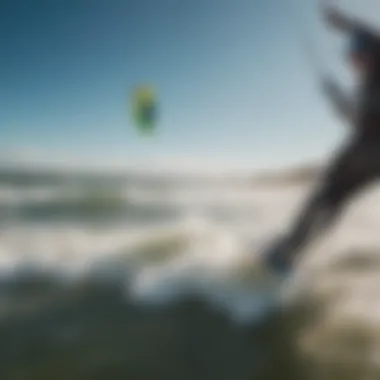
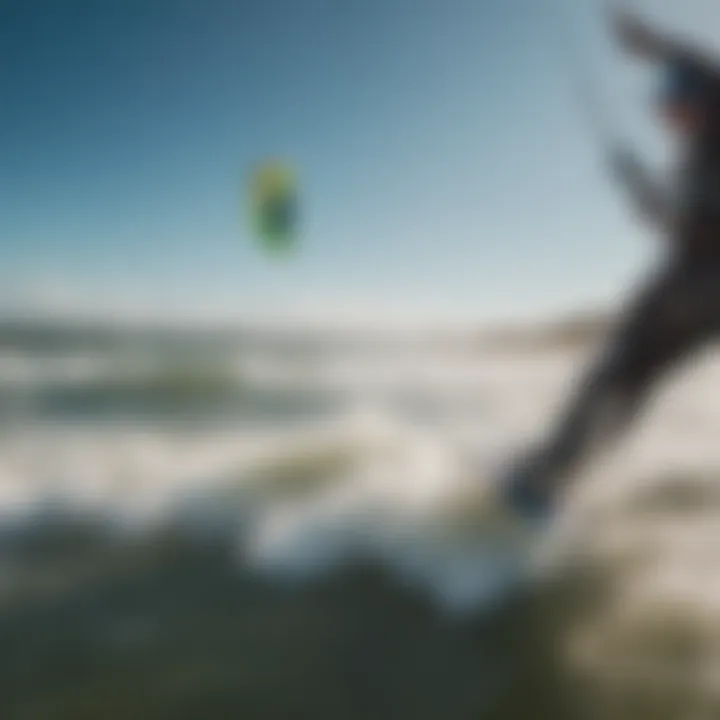
For instance, a forecast may describe wind speeds in terms of light, moderate, or strong.
- Light winds (usually up to 10 knots) are ideal for paddleboarding, allowing for peaceful gliding on calm waters.
- Moderate winds (10-20 knots) can create fantastic conditions for kitesurfing, providing enough push to power the kite without overwhelming the rider.
- Strong winds (over 20 knots) may signal rough surfing conditions, possibly requiring more advanced skills.
Besides wind speed, forecasts also provide wind direction. Understanding if winds are coming from the north or south can affect waves, current patterns, and ultimately your performance. Resources like weather.com or windy.com offer real-time wind predictions that can help you make informed decisions.
More importantly, several forecasting models exist. Some are particularly accurate for localized conditions. While no forecast is perfect, comparing multiple sources gives a clearer picture—much like putting together a puzzle. Be sure to pay attention to any warnings or advisories as well. They serve as red flags for impending conditions that might disrupt your plans.
Utilizing Wind Maps
Wind maps are another invaluable resource for wind interpretation. These color-coded visual representations of wind conditions can be quite telling. They simplify the complexities of meteorological data into an accessible format, allowing enthusiasts to visualize how wind flows through an area.
To make the most of wind maps, it’s important to know how to read them effectively. Here are some pointers:
- Colors Indicate Speed: Much like a traffic light lets you know when to stop or go, colors on a wind map show speed. Generally, blue indicates light winds, while red signifies strong winds.
- Direction Arrows: Look for arrows indicating wind direction. The way arrows point tells you where the wind is coming from. It’s a simple yet effective way to gauge conditions quickly.
- Updates Frequency: Most wind maps update in real-time or every few hours. Regularly checking them ensures you stay ahead of changing conditions.
Utilizing sites like wunderground.com or a mobile app dedicated to wind tracking can keep you informed while on the move. Many of these tools allow you to filter data according to your favorite spots.
Blockquote:
"Knowledge is power; having accurate wind data at your fingertips allows you to harness the elements to your advantage."
Navigating through meteorological data involves blending skills in interpretation and application of the available resources. Learning how to read forecasts and wind maps effectively can elevate not just your skills but also your safety, enjoyment, and performance in your chosen water sport.
Technological Advances in Wind Measurement
The way we understand and measure wind patterns has evolved significantly over the years. Until recently, obtaining accurate data on wind speed and direction was a challenging task, often dependent on observations that could be affected by various external factors. Today, however, cutting-edge technology offers tools that provide real-time insights into wind behavior. This is particularly crucial for surfers, kitesurfers, and paddleboarders, whose activities hinge on precise wind information.
Why is This Important?
Advancements in wind measurement technology empower water sports enthusiasts to make informed decisions, ultimately enhancing their performance and safety on the water. Reliable data allows for the optimization of wind-related strategies, ensuring that you’re riding the waves at the right moment. Whether you’re prepping for the next big swell or assessing kitesurfing conditions, knowing the wind patterns can make all the difference between a thrilling experience and a struggle against unfavorable conditions.
"Harnessing the right technology can mean the difference between getting lifted by the wind or being grounded by it."
Anemometers and Their Variants
Anemometers come in various types, each suited to different needs and contexts. These instruments measure wind speed and are crucial for both casual observers and professional meteorologists alike. Here are some prominent variants:
- Cup Anemometers: The classic design with three or four cups that rotate in the wind. They are often used in large-scale meteorological studies and can deliver highly accurate data.
- Vane Anemometers: These portable devices combine an anemometer and a wind vane, offering readings of both speed and direction. This makes them handy for individual users who need quick assessments of local conditions.
- Hot Wire Anemometers: Using a thin wire heated to a specific temperature, these devices measure cooling rates as wind flows past. They're particularly useful in controlled environments or laboratory measurements and can detect small changes in airflow.
In the context of water sports, having access to accurate wind speed readings through these anemometers can help athletes choose the best times and conditions to go out. Knowing if a gust is a friendly push or a punishing blast is central to enjoyment and safety.
Mobile Applications for Wind Tracking
The age of smartphones has introduced a new dimension to wind monitoring. Various mobile applications are available that provide instantaneous data on wind conditions, forecasts, and localized changes. Notable apps include Windy, Weather Underground, and KiteBuddy. These applications boast features like real-time alerts, detailed wind maps, and interactive interfaces, all designed with the water sports enthusiast in mind.
Benefits of using these mobile applications include:
- Accessibility: Users can check wind conditions from anywhere, even on the beach or while traveling.
- Custom Notifications: Set alerts for specific wind conditions that suit your sport. For example, kitesurfers might want updates when winds exceed a certain speed.
- Comprehensive Data: Many apps pull data from multiple sources, giving a rounded picture of what to expect. This can include marine forecasts, precipitation, and temperature, factors that often interact with wind behavior.
Case Studies of Local Wind Patterns
Understanding the local wind patterns isn’t just an academic exercise; it’s a practical necessity for anyone actively engaging in watersports. By looking closely at real-world examples, we can pinpoint how geography and weather systems shape the winds that ride in our backyard. These case studies give us a clearer view of how to navigate, anticipate, and ultimately excel in various aquatic activities.
Regional Differences
When one thinks about regional wind patterns, it’s like comparing apples and oranges. Each area has its unique characteristics that can drastically affect how the wind behaves. For instance, the coastal winds along the shores of California differ markedly from those found in the Great Lakes region.
- California Coast: Here, the wind is often influenced by ocean currents and nearby mountains, creating steady and predictable conditions perfect for surfing and windsurfing. The iconic Pacific breeze can be both a blessing and a challenge for surfers. Having the local knowledge about when and where to catch that perfect wave can mean the difference between success and a long day in the water chasing whitecaps.
- Great Lakes Region: On the other hand, the Great Lakes present a different picture. Wind patterns can shift rapidly due to the vast surface area of the lakes themselves and the surrounding landscape. This region can experience localized gusts and turbulent winds which should be taken into account when kitesurfing or paddleboarding. Wind breaks from buildings or trees can create unexpected eddies, making it essential for enthusiasts to watch for wind shifts when out on the water.


Understanding these regional differences will keep you on your toes and improve your performance in whichever water sport you choose.
Impact of Local Events on Wind Conditions
Local events—from thunderstorms to seasonal festivals—can dramatically change wind dynamics and should never be overlooked when planning an outing.
"In the world of wind, unpredictability is the norm; it's crucial to stay informed to ride the waves effectively."
- Thunderstorms: For instance, a thunderstorm can alter wind direction and speed in a very short window. Winds can pick up intensity very suddenly before and during these weather events. Those who understand this pattern can avoid hazardous conditions, positioning themselves in safe areas before the storm hits.
- Changing Seasons: As seasons flip from summer to fall, wind patterns can also undergo gradual but significant transformations. In the late summer, thermal winds from warm land could offer a pleasant ride, whereas winter may present more turbulent conditions owing to colder air masses descending from the north. Kitesurfers, especially, should keep an eye on seasonal forecasts to ensure optimal riding conditions.
To sum up, case studies illustrate how localized and dynamic wind patterns can dramatically affect watersport conditions. Palpably distinguishing these regional variances and being able to interpret local events can play a key role in maximizing enjoyment out on the water. By engaging deeply with these experiences, enthusiasts can steer clear of potential troubles and ride the winds with precision.
Safety Considerations Related to Wind
Understanding wind hazards is essential for anyone engaging in water sports, including surfers, kitesurfers, and paddleboarders. The ocean is a constantly shifting environment whose conditions can change rapidly. Knowledge of wind safety can greatly reduce the risk associated with these activities.
Understanding Wind Hazards
Wind hazards can manifest in various forms, affecting both water and weather conditions. For instance, a sudden gust can capsize a paddleboarder or change waves in a way that makes surfing untenable. It’s critical to recognize that wind isn't just a breeze; that strong gust can toss a rider off course or create dangerous conditions.
Some common wind hazards include:
- Gusty Winds: Sudden and unpredictable increases in wind speed can make controlling your board difficult.
- Offshore Winds: Especially dangerous for surfers, as they can blow you away from the safety of the shore.
- Winds Following Storms: These can produce irregular wave patterns and unexpected conditions, making it tricky to navigate waters.
- Wind Shadow Areas: Steering too close to high cliffs or buildings might result in sudden wind shifts that lose your control.
"Understanding wind hazards is as critical as knowing how to ride the waves."
Given these factors, athletes must be vigilant about local wind patterns and forecasts. Always check wind reports before hitting the water to recognize potentially hazardous conditions. Even seasoned surfers and water sports enthusiasts can underestimate how rapidly weather can turn.
Best Practices for Safety
Safety practices regarding wind should always be at the forefront of any water sport planning. Here are several guidelines to keep in mind to ensure your time on the water is enjoyable yet safe:
- Check Weather Forecasts: Regularly consult reliable weather forecasts and wind reports. Apps and websites specifically designed for water sports can provide crucial updates.
- Wear Appropriate Gear: Depending on wind conditions, wearing a personal flotation device is non-negotiable. Also, a wetsuit can shield you from chillier temperatures.
- Don’t Overestimate Your Abilities: Just because yesterday's conditions felt manageable doesn't mean today's weather will behave the same way. Always read the conditions hour by hour.
- Have a Plan: Always go to the water with a buddy. Notify someone offsite about your itinerary and what to do if things go awry.
- Stay Close to Shore: Especially as a beginner, maintaining proximity to the land gives you a quick escape if conditions worsen unexpectedly.
Effective wind safety requires a balance of preparation, knowledge, and experience. Use tools like wind forecasting apps and outdoor community groups on platforms such as Reddit to share concerns and seek advice about local conditions.
By remaining aware and implementing these practices, you safeguard not just your water sports experience but also that of others in your vicinity. The ocean is beautiful, but even the best laid plans can go awry in moments.
Adopting a proactive approach to understanding wind patterns directly influences your well-being and success in water sports.
Culmination and Future Considerations
As wind studies evolve, there are several key aspects to consider:
- Localized Knowledge: Mastering the wind patterns unique to your area can significantly enhance your effectiveness on the water.
- Adaptive Strategies: With the ability to predict and adapt to changing conditions, you can modify your techniques for better outcomes.
- Safety Measures: Familiarity with wind hazards allows for proactive planning to keep your outings fun and safe.
Thus, investing time in understanding these elements can bring your water sports skills to a whole new level.
The Evolving Nature of Wind Studies
Wind studies have come a long way from the days when they were merely based on anecdotal observations. Technological advances have made it possible to collect real-time data on wind patterns, ultimately enabling enthusiasts to reap the benefits.
Today's anemometers, satellite data, and mobile applications have democratized access to information that was once confined to meteorologists and academia. Changes in wind studies are geared towards:
- Real-Time Data Collection: Having accessible, live updates on wind conditions can help surfers and kitesurfers make informed decisions while out on the water.
- Community Collaboration: Enthusiasts can share findings and experiences through platforms like Reddit and Facebook, contributing to a larger dataset that can help refine wind condition predictions.
As new methods emerge to gather and process wind data, a greater understanding will lead to better predictive models. Those involved in wind studies are keenly aware that environmental shifts—caused by climate change and human activity—are changing local and global wind patterns.
Encouraging Awareness Among Watersport Enthusiasts
Raising awareness within the watersport community is paramount for both enjoyment and safety. Awareness doesn't just imply reading wind forecasts; it’s about developing a deeper understanding of how your local geography, weather conditions, and seasonal changes can influence your experience on the water. By fostering this awareness, enthusiasts can:
- Participate in Workshops: Community workshops focused on understanding local wind conditions can be invaluable. Learn about how terrain impacts wind flow and how different seasons can bring about distinct wind behaviors.
- Engage with Technology: Utilize mobile applications that provide real-time updates specific to your local area. Learning to interpret these tools can empower users to make educated choices.
By focusing on education and practical resources, the community can empower itself to embrace responsible and enjoyable practices when taking to the water. The more informed we are, the better we can honor nature while pursuing our passions.



